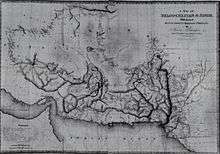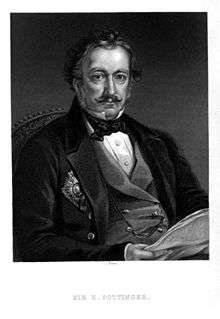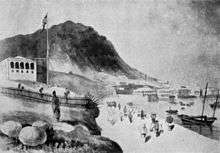Henry Pottinger
| Lieutenant-General The Right Honourable Sir Henry Pottinger Bt GCB | |
|---|---|
 | |
| Administrator of Hong Kong | |
|
In office 1841–1843 | |
| Monarch | Queen Victoria |
| Preceded by | Sir Charles Elliot |
| Governor of Hong Kong | |
|
In office 26 June 1843 – 8 May 1844 | |
| Monarch | Queen Victoria |
| Succeeded by | Sir John Francis Davis |
| Governor of the Cape Colony | |
|
In office 1847–1847 | |
| Monarch | Queen Victoria |
| Preceded by | Sir Peregrine Maitland |
| Succeeded by | Sir Harry Smith, 1st Bt. |
| Governor of Madras | |
|
In office 1848–1854 | |
| Monarch | Queen Victoria |
| Preceded by | The Marquess of Tweeddale |
| Succeeded by | The Lord Harris |
| Personal details | |
| Born |
3 October 1789 County Down, Kingdom of Ireland |
| Died |
18 March 1856 (aged 66) British Malta |
| Spouse(s) | Susanna Maria Cooke |
| Alma mater | Belfast Academy |
| Signature |
|
| Military service | |
| Allegiance |
|
| Service/branch | Bombay Army |
| Years of service | 1804–1856 |
| Rank | Lieutenant General |
| Battles/wars |
Third Anglo-Maratha War First Opium War |
Lieutenant General Sir Henry Pottinger, 1st Baronet, GCB, PC (Chinese: 砵甸乍; 3 October 1789 – 18 March 1856), was an Anglo-Irish soldier and colonial administrator who became the first Governor of Hong Kong.
Early career

Henry Pottinger was born in County Down, Ireland, in 1789. He was the fifth son of Eldred Curwen Pottinger, Esq., of Mount Pottinger, County Down, and his wife Anne, who was the daughter of Robert Gordon, Esq., of Florida House in the same county. They had three daughters and eight sons.[1][2][3] Eldred Pottinger was his nephew.[4] Henry studied at the Belfast Academy, today known as Belfast Royal Academy.
In 1804, he went to India to serve in the army and explored the lands between the Indus and Persia, travelling in disguise as a Muslim merchant and studying local languages, under the orders of Sir John Malcolm. In 1806, he joined the British East India Company and in 1809, he was a Lieutenant who fought in one of the Anglo-Mahratta wars before rising to the rank of Colonel after his dangerous 1810 expedition from Nushki (Balochistan) to Isfahan (Central Persia). It would be 100 years before another European took this route. This expedition was funded by the East India Company to map and research hitherto unstudied regions of Beloochistan (Balochistan) and Persia because of concerns about India being invaded by French forces. Pottinger later became Resident Administrator of Sindh in 1820. He later held the same post in Hyderabad.
In 1820, he married Susanna Maria Cooke who in 1831 gave birth to their son, William Frederick who would go on to become notorious for his run-ins with bushrangers as Inspector of Police in New South Wales in Australia. Their second son, Henry, was born on 10 June 1834 and died on 18 October 1909.
He was created a baronet when he returned to England in 1839.
Governor of Hong Kong

Pottinger accepted Foreign Secretary Lord Palmerston's offer of the post of envoy and plenipotentiary in China and superintendent of British trade, thus replacing Charles Elliot.[5] In 1841, when Pottinger was sent to China, Palmerston instructed him to "examine with care the natural capacities of Hong Kong, and you will not agree to give up that Island unless you should find that you can exchange it for another in the neighbourhood of Canton, better adapted for the purposes in view; equally defensible; and affording sufficient shelter for Ships of War and Commerce".[6] On 4 November 1841, Palmerston's successor Lord Aberdeen wrote to Pottinger that he had doubts over Hong Kong's acquisition since it would incur administrative expenses, and complicate relations with China and other nations.[6]

After Pottinger led a navy to defeat Yishan at Humen, he negotiated the terms of the Treaty of Nanking (1842), which ended the First Opium War and ceded Hong Kong Island to the United Kingdom. Pottinger became the second administrator of Hong Kong (1841–1843) and the first Governor of Hong Kong (1843–1844). When he forwarded the treaty to Aberdeen, Pottinger remarked, "the retention of Hong Kong is the only point in which I have intentionally exceeded my modified instructions, but every single hour I have passed in this superb country has convinced me of the necessity and desirability of our possessing such a settlement as an emporium for our trade and a place from which Her Majesty's subjects in China may be alike protected and controlled."[7]
On 26 April 1843, the Governor's residence (Former French Mission Building) was robbed.
On 26 June 1843, he was appointed to become the Chief Commander of the British troops stationed in Hong Kong.
During his very short tenure, Pottinger established executive and legislative chambers, with one discussing political affairs and one designing legal codes. However, the chambers did not convene often, and this gave Pottinger wide-ranging powers to decide on policy.
Towards the end of his tenure, Pottinger lost the support of the local British merchants and was isolated. He left on 7 May 1844.
During his governorship, Hong Kong became the major port for trading opium in China.
Post-governorship
Pottinger became a member of the Privy Council in 1844, and became Governor of the Cape Colony in 1847 and also of Madras in the same year. In 1851, he was promoted to the rank of lieutenant-general.
He died in retirement in Malta in 1856.
Legacy
- Pottinger Street in Central, Hong Kong Island
- Pottinger Peak on Hong Kong Island near Siu Sai Wan
- Pottinger Gap between Pottinger Peak and Mount Collinson
- Pottinger Battery, at Devil's Peak, Hong Kong
- Pottingers Entry off High Street in Belfast, Northern Ireland
- Pottinger House, Belfast Royal Academy, his former school, named a house in his honour.
- Mount Pottinger in East Belfast
- Pottinger constituency in Parliament
See also
- Pottinger Baronets
- History of Hong Kong
- Keying 耆英 (Qiying), the Manchu official, Pottinger's counterpart in Hong Kong.
References
- ↑ "Our Portrait Gallery—No. XL.". The Dublin University Magazine 28: 426.
- ↑ Walford, Edward (1857). "Right Hon. Sir H. Pottinger, G.C.B.". Hardwicke's Annual Biography for 1857. p. 20.
- ↑ Urban, Sylvanus (January–June 1856). "Obituary.—Right Hon. Sir H. Pottinger.". The Gentleman's Magazine 45 (new series): 517.
- ↑ Pottinger, Henry (2 November 1846). "Letter from Sir Henry Pottinger". The Dublin University Magazine 28: 768.
- ↑ Broadfoot, William. "Pottinger, Sir Henry, first baronet (1789–1856)". Oxford Dictionary of National Biography (2004 ed.). Oxford University Press. doi:10.1093/ref:odnb/22626. Accessed 20 July 2010.
- 1 2 Tsang, Steve (2004). A Modern History of Hong Kong. I.B. Tauris. p. 17. ISBN 1-84511-419-1.
- ↑ Pottinger, George (1997). Sir Henry Pottinger: First Governor of Hong Kong. Sutton Publishing. p. 106. ISBN 0-312-16506-4.
Bibliography
- Endacott, G. B. (2005) [1962]. A biographical sketch-book of early Hong Kong. Hong Kong University Press. ISBN 978-962-209-742-1.
External links
 Media related to Henry Pottinger at Wikimedia Commons
Media related to Henry Pottinger at Wikimedia Commons
| Government offices | ||
|---|---|---|
| Preceded by Charles Elliot |
Chief Superintendent of British Trade in China 1841 |
Office abolished |
| Administrator of Hong Kong 1841–1843 |
Succeeded by Himself as Governor of Hong Kong | |
| Preceded by Himself as Administrator of Hong Kong |
Governor of Hong Kong 1843–1844 |
Succeeded by Sir John Francis Davis |
| Preceded by Sir Peregrine Maitland |
Governor of the Cape Colony 1847 |
Succeeded by Sir Harry Smith, Bt |
| Preceded by The Marquess of Tweeddale |
Governor of Madras 1848–1854 |
Succeeded by The Lord Harris |
| ||||||||
|

